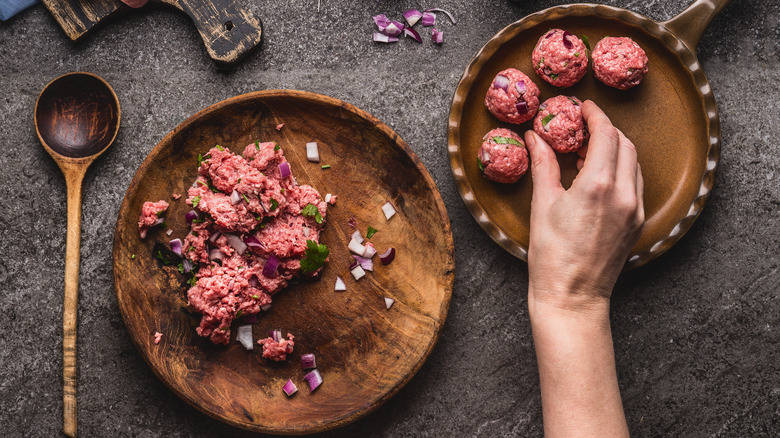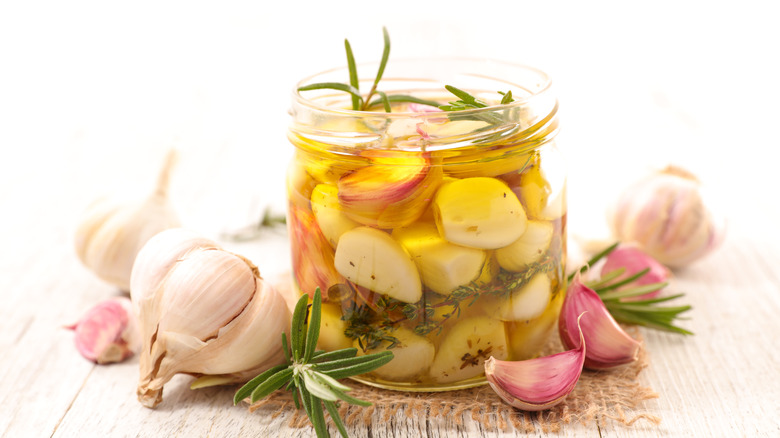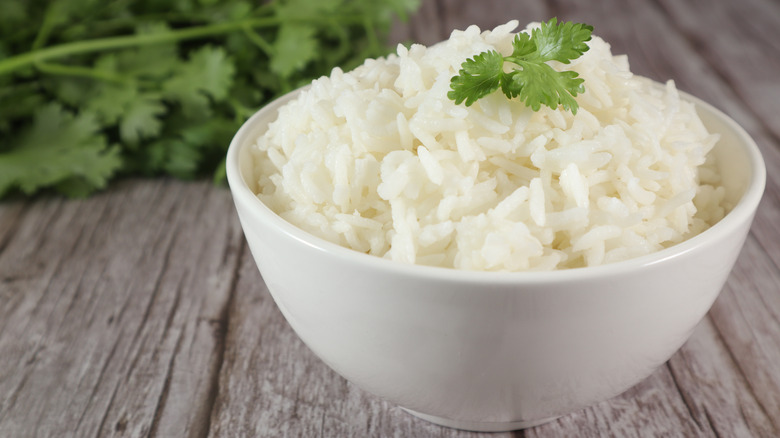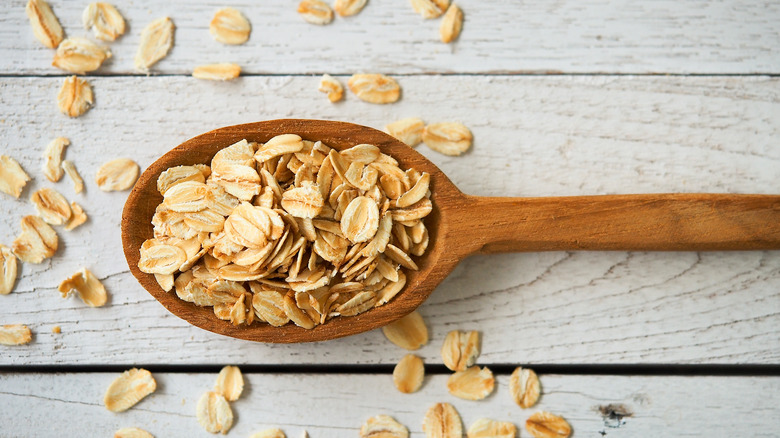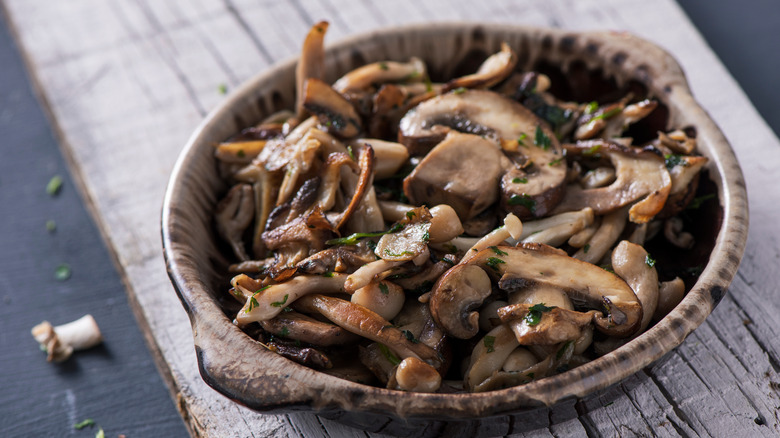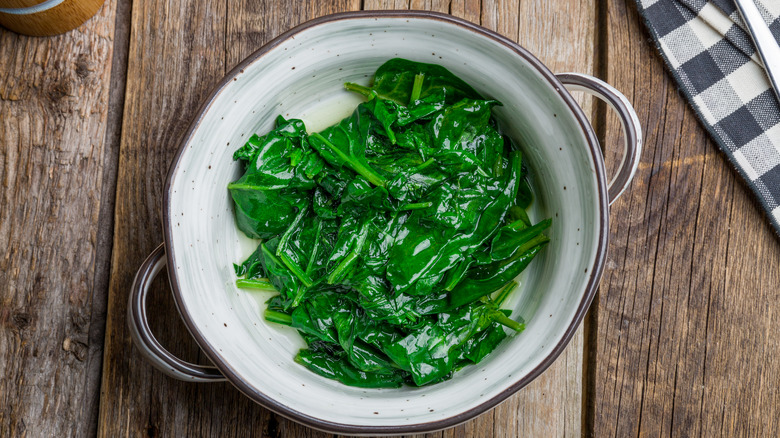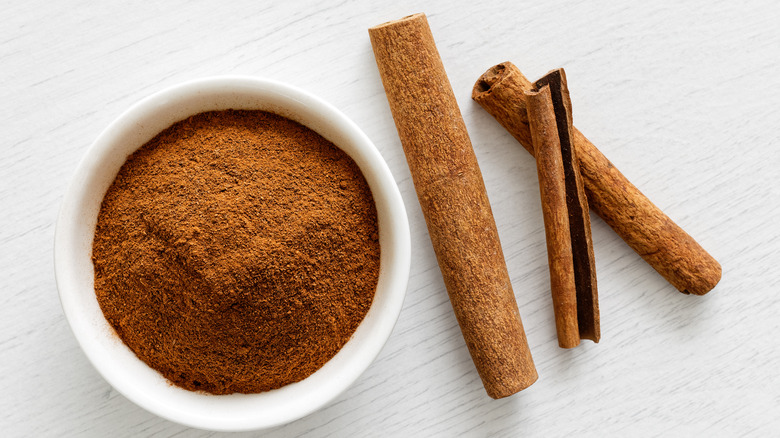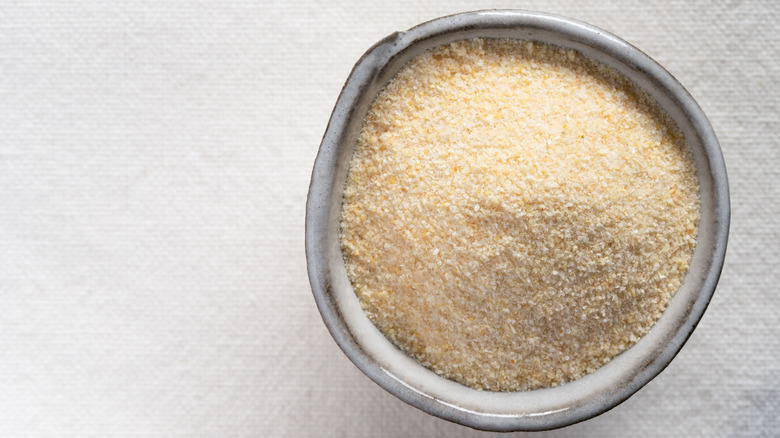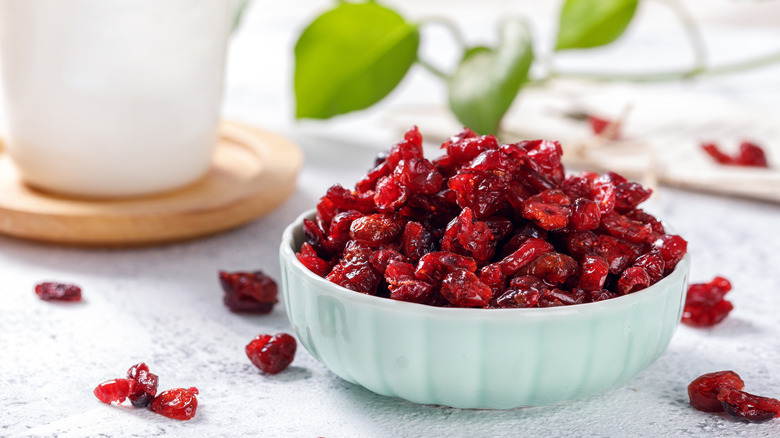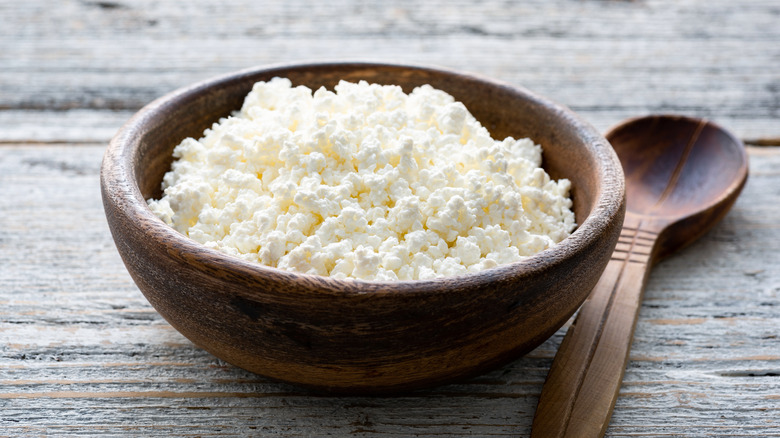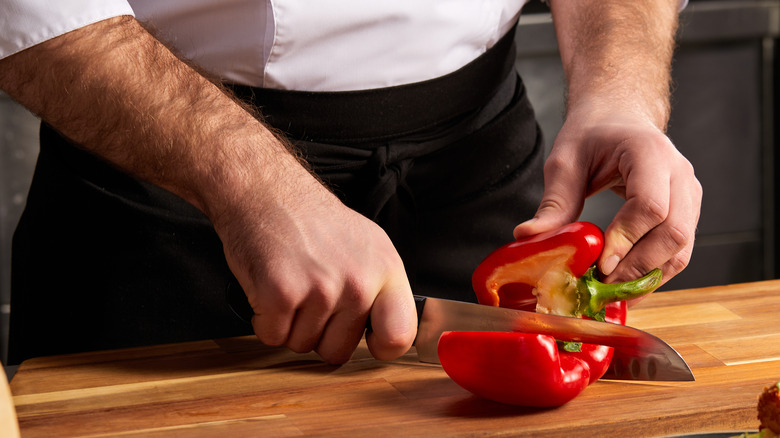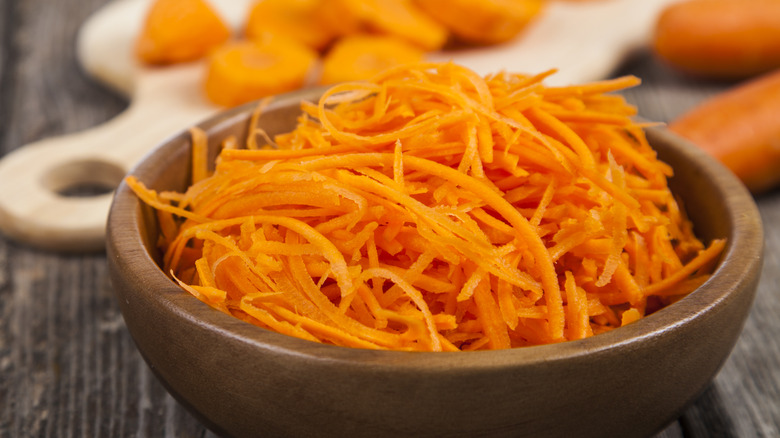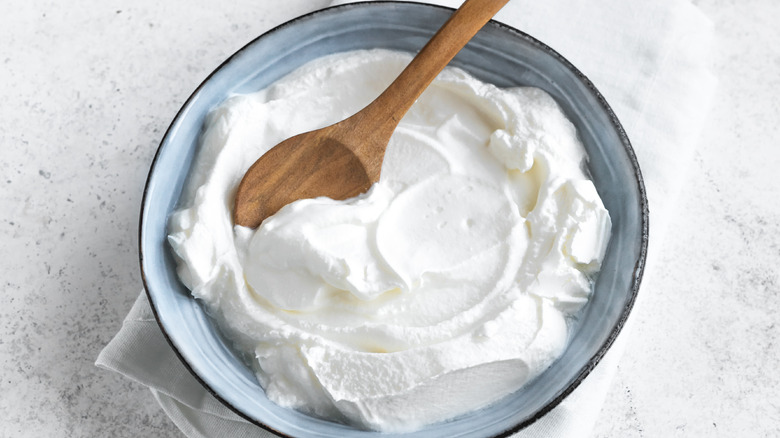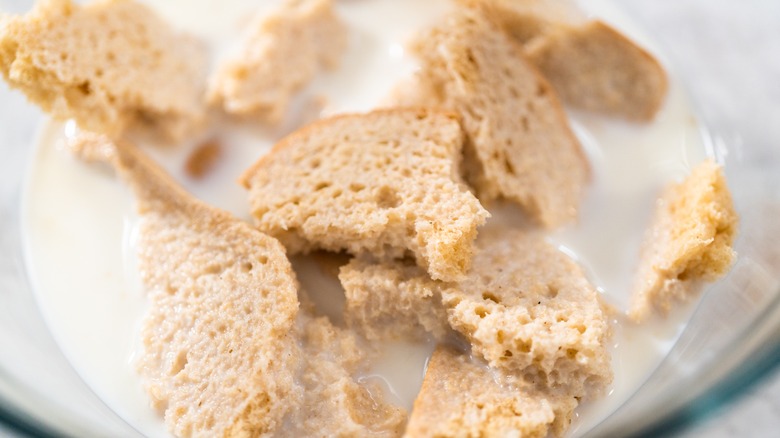14 Ingredients That Will Take Your Meatballs To The Next Level
You might think it is tedious to make meatballs, especially when you involve new elements. Fortunately, that's not the case, as they can be simple and enjoyable to make, even if it's your first time making them. Classic meatballs are typically made with meat, breadcrumbs, eggs, seasonings, and herbs. However, it's also not uncommon to include garlic, parmesan, and onion.
When you're choosing the best type of meat to use for meatballs, you'll have the best-tasting results when you combine multiple kinds rather than just sticking to one. But, like everything else in the culinary world, that's up for debate. Although the basic ones are tasty, there are numerous ways to elevate the dish with just a few tweaks. You can swap one ingredient for another, like replacing the breadcrumbs with something else. You can also throw in a creamy component to make them juicer. Not to mention, mix-ins perform wonders for textural improvement. When you give new ingredients a shot, your meatballs reach new heights. Dry, flavorless meatballs will be a thing of the past. So, let's get into a few ingredients you should try next time you're making meatballs
1. Garlic confit
Garlic confit, or oil-soaked garlic that you slowly cook, is superb for making meatballs because the garlic flavor is more profound than minced garlic. Garlic and meat are no strangers to each other, and garlic works well in nearly any meatball recipe. You can throw it into a prime beef meatballs recipe, which calls for only 1 tablespoon to make six meatballs.
If you don't already have it on hand, making a large batch is fairly easy and comes in handy for a lot of other dishes. On average, garlic confit calls for two heads of garlic. All you need to do is place the cloves on the pan with some olive oil and let it cook for a little bit less than an hour. If you want to use it in your meatballs, you can chop the soft garlic and throw it in to distribute the flavor throughout. Or, for a more elegant approach, assemble the meatballs and place a cooked garlic clove in the center. This way, you're met with rich garlic confit when you bite into the stuffed meatballs.
2. Rice
If you've ever tried porcupine meatballs, you know how tasty rice-packed meatballs are. For those who don't know, in the Depression era, people would put rice in their meatballs to bulk them up, which made the dish more filling. This ingredient gives the meatballs a unique texture because the rice protrudes, which is how the name "porcupine meatballs" came about.Try making them with a sauce or create your own rice-filled meatballs. A good tip to keep in mind is to use instant rice. If you use other kinds, there is a chance the rice only partially softens during the cooking process.
For example, the slow cooker porcupine meatballs recipe calls for Minute brand rice instead of standard rice. The meatballs cook for five hours, which gives the rice plenty of time to become tender. Alternatively, if you have leftover cooked rice, you can use it in your meatballs. Just be sure not to over-mix it, or else the pre-cooked rice gets clammy. So long as you're careful, using the leftovers reduces food waste and supplies you with bulky meatballs that satisfy your hunger.
3. Old fashioned oats
Try substituting the breadcrumbs in meatballs with oats next time you make some. The oats are fantastic because they soak up all the recipe's liquids, making the meatballs tender. This ingredient is especially suitable for recipes with lean ground meats, which are at risk of becoming dry. Luckily, oats offset their lack of fat. Ideally, you should replace all of the breadcrumbs with oats. As an alternative, you can also use a bit of both in the same recipe. Since oats are mostly bland, they pair well with any ingredients in the meatball recipe you wish to use.
When you add spices to your liquid components, the oats take on the flavors of the seasonings, which you can use to your advantage. Alternatively, make lean ground pork meatballs with the addition of oats. You can then serve them with a spicy glaze or garlic sauce.
A perfect way to use oat-filled meatballs is to make albondigas soup with them. To make the soup, you can use half oats and half breadcrumbs mixed with lean ground beef, rice, and seasonings.
4. Mushrooms
Mushrooms provide a rich flavor that harmonizes well with any meat blend you choose to use. To use them in a meatball recipe, roast the mushrooms in the oven first. Next, chop them into quarters or eighths, depending on how large they are. Then, place them on a sheet pan and drizzle them with oil and seasonings. Once the mushrooms cool down, incorporate them into your meatball mixture. There are numerous types of mushrooms, and some work better than others in meatballs, so spend some time deciding which ones you want to make.
A few stand-out options are cremini, shiitake, portobello, and button mushrooms. Portobello mushrooms are pretty meaty in texture, so they fit right in with the other hearty meatball components. Button mushrooms are beneficial because they are more tender once cooked and are usually the easiest to find in the grocery store. However, all choices listed provide the meatballs with evident umami notes. Reserve some of the roasted mushrooms to include them in a gravy or sauce, which transforms your meal into a delicious masterpiece.
5. Spinach
Spinach is a wonderful addition to meatballs. Its earthy essence is heavenly when you use it with spices, herbs, and meat. It shines in recipes like turkey mushroom meatballs, where you combine it with onions, Panko, turkey, garlic, and more. Either fresh or frozen spinach will get the job done. Regardless of which you choose, you should cook and drain the spinach before you use it in meatballs. If you fail to drain it, it can make your meatballs watery, which causes them to fall apart.
For the best outcome, chop the spinach into small pieces. Doing so will also help the spinach blend with the other components. It is pleasantly soft when you cook it, which suits the dish better than if you leave it raw. According to Healthline, spinach has significant amounts of fiber, vitamin C, vitamin K1, and iron, which makes it all the more enticing to add to your meatballs. Not to mention, it also helps promote healthy digestion.
6. Cinnamon
Next time you make meatballs, throw in a dash of cinnamon. If you've never used cinnamon in a savory meal, it might be a bit intimidating, but once you try it, you'll notice how advantageous it can be. Many dishes, like Moroccan meatballs, use cinnamon as an ingredient. When you pair cinnamon with cloves and cumin, it brings out other flavors in the food, such as fresh herbs, garlic, and meat.
Many spice blends worldwide are ideal for meatballs and include cinnamon. To name a few, five spice, berbere, and ras el hanout are all spice blends that use cinnamon for warmth. Whichever way you choose to use this ingredient in your meatball meal, just remember that less is more. Start with a pinch or two and work your way up from there — or perhaps, that's all you need. After all, you don't want your meatballs to taste like cinnamon. Instead, think of cinnamon as an ingredient that enhances other components in your recipe.
7. Onion soup mix
One sure way to make flavorful meatballs is to throw any premade seasoning mix into the recipe, such as Lipton's onion soup mix. Of course, you can use other packaged seasonings, but this onion soup mix is extra tasty because it has a deep flavor reminiscent of caramelized onions. In addition, depending on the brand, onion soup mix has other ingredients like salt, sugar, beef fat, onion powder, and soy sauce. These components are great no matter which type of meatball you make, whether you want to create a new recipe or include them in your favorite family recipe.
When you use the Lipton soup mix, you should start with a little since the flavors are so rich. Be sure to mix the product thoroughly when you incorporate it into any meatball recipe. Otherwise, certain spots might have concentrated amounts of seasoning, which will make cooking your meatballs evenly difficult. To make it easy, evenly mix the onion dip packet into the breadcrumbs first. When you use this simple approach, the taste of the meatballs becomes much more pronounced.
8. Dried cranberries
Dried cranberries have sugary yet tart qualities that make the fruit a perfect addition to any meatball recipe. Aside from their distinct taste, the dried fruit has a unique texture that is somewhat chewy and differs from typical meatball ingredients. They're also easy to work with since they're small — you don't need to chop them. There is no exact number of dried cranberries you should use in a recipe, as it is up to your preference, but you likely don't need more than a cup. Fresh cranberries are not always in season, so we recommend dry ones. If you prefer the cranberries to be plumper, you can soak them in water.
In fact, one of the best tips when working with cranberries is to rehydrate the dry ones you plan to cook. Use hot water to introduce moisture to the cranberries. Allow them to rest submerged in the water for at least 15 minutes before you use them in a recipe.
The best cranberry meatball recipes have cranberries in both the meat mixture and the sauce. The astringency of the cranberries plays off the hearty ingredients to create flavor, depth, and contrast. Of course, if you don't want to use a cranberry sauce, there are other glazes and sauces that are a good match for cranberries and meat, like orange sauce, gravy, or sweet and sour sauce.
9. Ricotta
Ricotta prevents meatballs from being dried out, so it's no wonder that this is the ingredient Michael Symon loves to add to his meatballs. Symon learned just how beneficial this addition is from his mother, who used to cook meatballs for him as a child. Specifically, he uses 1 cup of ricotta in his recipe for 1½ pounds of meat. So, there is three times the amount of meat as there is ricotta. Use this ratio in any meatball recipe, and you shouldn't be disappointed.
You can also follow recipes like spaghetti with ricotta beef meatballs and marinara sauce, which has a smaller cheese-to-meat ratio. For this recipe, the ricotta is mixed with eggs, breadcrumbs, and cooked shallots. Even a tiny amount of ricotta is better than none, as it helps create softer meatballs. Overall, the taste of ricotta is relatively mild. It is sometimes slightly sweet or nutty, but not so much that it overpowers the herbs and spices in the meatballs. Therefore, you shouldn't worry about it altering the dish's flavor too much.
10. Cheez-Its
Cheez-Its instead of breadcrumbs make a fantastic option because the Cheez-Its provide the meatballs with a cheesy undertone, which pairs well with whichever meat you use. The crackers also have hints of paprika and salt. If you want to enhance the flavor even more, try using different Cheez-It flavors aside from the original. There are also variations made with different types of cheese, like pepper jack or white cheddar, which taste just as delicious.
Making Cheez-It meatballs is more simple than you might think. All you need is a food processor to break them down into a similar texture to breadcrumbs. If you don't have a food processor, another option is to crush them by hand. A good hack is using a Ziploc bag and a meat mallet to smash them — a rolling pin or anything on the heavier side will also work. Finally, they just need to be soaked in milk for some time, then proceed with your regular meatball recipe as normal.
11. Bell peppers
Add bell peppers to your next batch of meatballs for a simple and delicious addition. Feel free to use green, yellow, or red bell peppers – really, any color works. Just remember, the ripeness of the peppers determines their flavor. For instance, if you use green bell peppers, they have a slightly bitter taste to them. Meanwhile, the red bell peppers tend to be on the sweeter side, with yellow and orange peppers falling in the middle of the spectrum. No matter which type you choose, the vivid colors of the peppers stand out when you bite into the meatball.
With this ingredient, you have the option to cook them before you introduce them to the meat mixture or leave them raw. For folks who don't necessarily enjoy the taste of raw peppers, a quick sauté on the stovetop does the trick. When you use any peppers, you need to dice them finely. And we're not talking about a rough chop that leaves chunky pieces but rather mincing them.
If you include large cuts of any vegetable in the mixture, it's likely the reason why your meatballs fall apart, as they prevent the meat from binding properly. If you don't know which ingredients are a good match for bell peppers, try something like a garden meatball recipe with diced green chiles, onions, celery, and peppers.
12. Carrots
Carrots are the sweet ingredient you should add to your spaghetti and meatballs. Carrots are recommended in this dish because their sweetness flawlessly balances the acidity of the tomatoes. Many people include this vegetable in their sauce for that reason, so why not add some to your meatball mixture too? Even if you do not serve them with tomato sauce, the carrots will add a really nice flavor to your meatball dish.
To begin, dice the carrots into tiny pieces and cook them before mixing them in with your meatballs — fork-tender pieces are what you should aim for. Otherwise, you'll get a hard crunch inside your meatballs. If you're wary of chopping too many carrots, another great recipe to try is slow-cooker meatballs which use processed carrots and a variety of veggies. This method saves you from chopping the carrots and guarantees their sweetness is thoroughly distributed throughout the meatballs.
13. Yogurt
Similar to the ricotta trick we mentioned earlier, yogurt will introduce plenty of moisture to your dish, preventing dryness from taking over. After all, the best type of meatball is juicy and flavorful, not dry and hard to get down without a giant glass of water. Greek yogurt is optimal because it is thick and won't make the raw meatball mixture watery. It also has hints of tanginess which will make for a flavorsome meatball when you couple it with savory components like fresh herbs and cheese.
Whichever yogurt you end up going with, you should avoid fruit-flavored yogurts because they make the meatballs taste quite funky. You should use around 1 cup of Greek yogurt for a full-batch recipe. Use your best judgment and add more if it isn't enough. For thinner kinds of yogurt, use a bit less. The final result is better if you mix the yogurt with eggs and breadcrumbs first.
14. Panade
We'll let you in on a secret: Making panade is one of the easiest ways to ensure juicy meatballs. What is panade, you ask? In its simplest form, it is a paste you create from bread, milk, and sometimes eggs, depending on how you are using it. Since many meatball recipes already call for these ingredients, it only makes sense to use the mixture in your favor.
To create a panade yourself, soak the bread in the liquid to dampen it. Then, add the eggs. Use equal parts bread and milk for recipes that don't initially require milk. There shouldn't be any extra liquid, as the bread absorbs it all and turns to mush. This is also one of the wise ways to use day-old bread because it restores it back to life if it's gone stale. Finally, incorporate the panade into the recipe with the meat and other ingredients. With this technique, the meatballs turn out succulent as ever.
